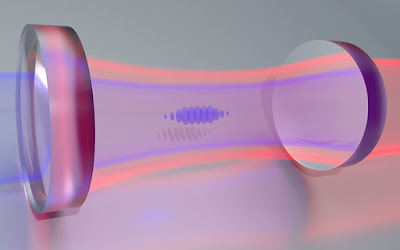 |
| Illustration of a gas of 500,000 atoms in an optical trap. (Courtesy: Onur Hosten) |
Topics: Bose-Einstein Condensate, Modern Physics, Quantum Mechanics
Bell correlations – a hallmark of an entangled quantum system – have been spotted in an ensemble of 500,000 rubidium-87 atoms. The atoms were prepared in spin-squeezed states by physicists at Stanford University in the US and the correlations measured to a whopping statistical significance of 124σ.
In quantum mechanics, entangled particles have much stronger correlations than are allowed in classical physics – a property that can be exploited in quantum technologies including cryptography. In 1964 the physicist John Bell famously calculated an upper limit on how strong these correlations could be if they were caused by classical physics alone – what has become known as Bell's inequality. Correlations stronger than this limit, Bell reasoned, could occur only if the particles are entangled.
In this latest work, Onur Hosten, Mark Kasevich and colleagues have measured these strong Bell correlations in an ensemble of 500,000 cold rubidium-87 atoms that are trapped by laser light. The atoms are put into an entangled state using a process called spin squeezing. The uncertainty principle dictates that the uncertainty in a measurement of the z-component of the total spin of the system multiplied by the uncertainty in the y-component must be larger than a certain value. Reducing (or squeezing) the uncertainty of the z-component increases the uncertainty of x-component, putting the system into a spin-squeezed state.
Physics World: Bell correlations measured in 500,000 atoms, Hamish Johnston
Related Link
Science Mag: Bell correlations in a Bose-Einstein condensate
Roman Schmied1,*, Jean-Daniel Bancal2,4,*, Baptiste Allard1,*, Matteo Fadel1, Valerio Scarani2,3, Philipp Treutlein1,†, Nicolas Sangouard4,†

No comments:
Post a Comment